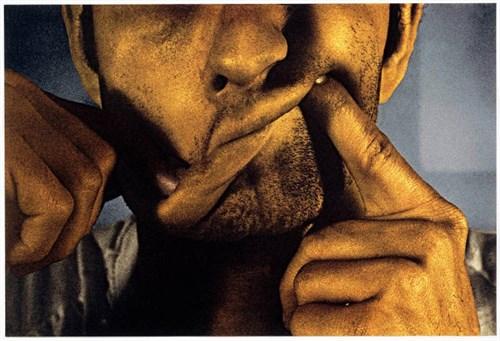The Academy of Art Museum transforms itself into a time machine, taking passengers as far back as 6th century B.C. all the way up to 21st century A.D., with three exhibits that are really four.
The large galleries that flank the museum lobby are devoted to “Recent Acquisitions: Photography @ AAM.” Among high-profile names in the space to the right is living artist Bruce Nauman, who says of his art, “I’ve never been able to stick to one thing.” Instead, he does it all—painting, sculpture, photography, video, neon, printmaking, neon. At AAM, he’s the subject of his own art—distorting facial features shot by Jack Fulton and printed with a textured bronze finish onto four funhouse images.
Others in this collection, selected by curator Anke Van Wagenberg, include black-and-whites you’d expect from Ansel Adams’ aesthetic for natural beauty and Berenice Abbott’s documentary-style stills of urban life. But many of us, myself included, may pause longest at Ed Clark’s 1958 photo of the future president peering into his daughter’s eyes in her bassinet.
Crossing the lobby into another gallery of “Recent Acquisitions”—all by John Gossage, among the foremost living American photo book-makers—are displayed along with a copy of the volume, republished in 2010 on the 25th anniversary of “The Pond.” The 47 images capture the counter-beauty of a neglected wooded area hidden in suburbia. Gossage’s project has been described as “a foil to Henry David Thoreau’s ‘Walden Pond.’ ” Hardly idyllic except for its unattended isolation. If you’re into that.
Upstairs, “Matthew Moore: Post-Socialist Landscapes” recall the Cold War era some of us glimpsed on black-and-white TV. But these scenes derive from Moore’s 2014 artists-in-residence at Lithuania’s Nida Art Academy. His haunting frames reveal urban and rural spaces in countries once occupied by the Soviet Union. Among these are “Discarded Icons: Memento Park, Hungary” with busts of Stalin and Lenin glowering in prison-like storage. Another “Discarded Icon” in Estonia finds a severed sculpture-head of Lenin sprouting from the ground in weeded obscurity. Other images reveal platforms in former Russian-dominated republics from which Stalin and Lenin statuary once commanded the view. Ominous superpower threats are amplified by shots of abandoned missile sites and forgotten nuclear bunkers.
Combat is hand-to-hand in the small first floor galleries where “Dressed to Kill in Love and War: Splendor in the Ancient World” resides on loan from New York’s Fortuna Fine Arts. Objects from centuries on either side of the birth of Christ feature Roman Empire warrior helmets, Greek and Hellenistic jewelry and decorative objects, plus photos of reliefs inspired by battle heroism and mythology. The exhibit’s romantic aspect is reflected in precious-metal jewelry rewarded to love interests of men on the winning side. If you really could go that far back in time, decline and stay safe at this under-glass peek. No cells, no indoor plumbing, no artillery to clear a path for your warhorse.
“Dressed to Kill in Love and War: Splendor in the Ancient World” Through March 31.“Recent Acquisitions: Photography @ AAM” and “Matthew Moore: Post-Socialist Landscapes” Through April 7, all at Academy Art Museum, 106 South St. Easton, academyartmuseum.org, 410-822-2787
Steve Park is a former art and theatre critic for Newsday on Long Island. He now lives on the Mid-Shore of Maryland.






Write a Letter to the Editor on this Article
We encourage readers to offer their point of view on this article by submitting the following form. Editing is sometimes necessary and is done at the discretion of the editorial staff.